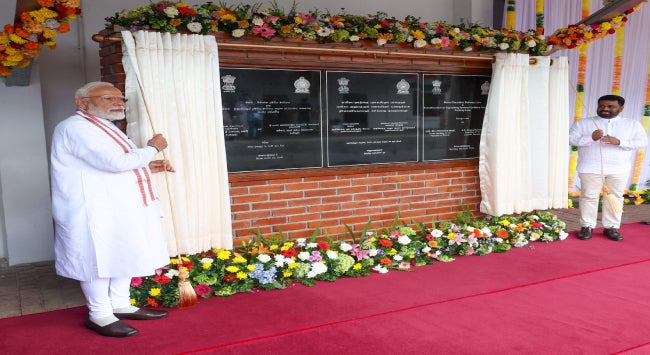Summary
Indian Prime Minister Narendra Modi’s visit to Sri Lanka in early April 2025 marked his first trip since President Anura Kumara Dissanayake took office in September last year. The visit involved the signing of several memoranda of understanding on key sectors such as energy, digitalisation, security and healthcare and the initiation of several projects in the power and energy sectors.
Indian Prime Minister Narendra Modi’s visit to Sri Lanka on 4 April 2025 marked the first visit by a foreign national leader following the election of President Anura Kumara Dissanayake in September 2024. Despite initial concerns that the National People’s Power (NPP) government would lean closer towards China due to historical antagonism towards India by the Janatha Vimukthi Peramuna (its main political party) and its former Marxist-Leninist ideology, India’s engagement with Sri Lanka has been consistent and reciprocated. This was evident in multiple visits by Minister of External Affairs S Jaishankar and the Sri Lankan president’s first official overseas visit to India late last year.
Modi’s visit to Colombo followed immediately his attendance at the Bay of Bengal Initiative for Multisectoral Technical and Economic Cooperation (BIMSTEC) summit in Thailand, where he strengthened his commitment to India’s ‘Act East’ policy and deepened India’s regionalism. The summit proposed a BIMSTEC Free Trade Agreement, whose significance is heightened in the wake of the announcement of tariffs by the United States (US) and challenges to the global multilateral trade regime.
Bilateral relations between the two countries had been adversely affected by India’s foreign policy towards Sri Lanka during its ethnic conflict and Sri Lanka’s growing engagement with China. Since 2022, bilateral relations have improved significantly as India played a key role in the immediate aftermath of Sri Lanka’s foreign debt crisis in 2022, providing US$5 billion (S$6.7 billion) in aid and supporting Sri Lanka’s application for an International Monetary Fund bailout. During the Indian prime minister’s recent visit, Sri Lanka completed a bilateral debt restructuring of US$1.4 billion (S$1.9 billion) with India, which included converting hundred million dollars of loans into grants and India lowering the interest rates on loans extended to Sri Lanka.
Memoranda of Understanding and Key Projects Initiated
There were seven memoranda of understanding (MoU) signed during the visit on key sectors such as energy, digitalisation, security and healthcare, among which the implementation of HVDC interconnection for the import/export of power and cooperation in the development of Trincomalee as an energy hub were especially significant. The Trincomalee hub in the strategically important eastern coast involves the construction of a multiproduct pipeline. The project also involves the United Arab Emirates, a strategic partner of India, and whose involvement may offset geopolitical tensions of engaging bilaterally and tapping into mutual strategic competencies. The project may intensify competition between India and China, as China’s state energy company Sinopec secured a deal to construct a US$3.2 billion (S$4.3 billion) oil refinery in Sri Lanka’s southern Hambantota port.
In addition, five projects were launched, including the inauguration of an upgraded railway track of the Maho-Omanthai railway line, a 120-megawatt Sampur solar power plant in Trincomalee and the inauguration of a temperature-controlled agricultural warehouse in Dambulla.
Potential Bilateral Tensions
The ongoing India-Sri Lanka fisherman issue, a longstanding point of bilateral tension, witnessed Sri Lanka releasing 14 Indian fishermen during Modi’s visit as a goodwill gesture. Ahead of Modi’s visit, the Tamil Nadu Legislative Assembly passed a resolution urging the Union government to reclaim Sri Lanka’s Katchchatheevu island. After the visit, Tamil Nadu’s Chief Minister M K Stalin accused Modi of failing to address the Katchchatheevu dispute and the arrests of fishermen despite the Tamil Nadu state resolution demanding action. These issues are politically sensitive for the new Sri Lankan government. The NPP government performed well in Tamil-majority areas in elections last year and seeks a similarly strong mandate from these areas in the upcoming local government elections in May 2025.
Additionally, the proposed Adani Group US$440 million (S$595.1 million) wind power project in the northeastern regions of Mannar and Pooneryn, aiming to develop 484 megawatts of wind power, was met with political controversy during elections in Sri Lanka last year. The NPP pledged to cancel the project during its election campaigns and, in February 2025, Adani Green Energy Ltd withdrew from the project, citing “financial nonviability”. The Sri Lankan government had indicated before this that it would continue with the Adani investment in the Colombo Port West Container Terminal despite bribery allegations against Adani in the US.
Defence Pact and the China Factor
India is seen to be attempting to convert its economic leverage into security gains in Sri Lanka. During the visit, a defence pact was signed, with the Sri Lankan president reaffirming the country’s commitment to not allowing its territory to be used against India’s security or regional stability. India’s Foreign Secretary Vikram Misri described the defence sector MoU as an “umbrella agreement” which provides a framework to pursue ongoing defence cooperation in a more “structured” manner.
The bilateral defence pact could push the Sri Lankan government into a strategic embrace with India, complicating efforts to assure China of its strategic interests. In 2024, the Sri Lankan government imposed a now-lifted ban on foreign research vessels following concerns by the Indian government about Chinese ships and submarines in regional waters. Pursuing an equidistant foreign policy is an increasingly difficult challenge for the Sri Lankan government due to the country’s structural economic weaknesses, geopolitical rivalry in the region and shifting American relations and priorities in the Indo-Pacific.
. . . . .
Dr Rajni Gamage is a Research Fellow at the Institute of South Asian Studies (ISAS), an autonomous research institute at the National University of Singapore (NUS). She can be contacted at r.gamage@nus.edu.sg. The author bears full responsibility for the facts cited and opinions expressed in this paper.
Pic Credit: X
-
 More From :
More From :
-
 Tags :
Tags :
-
 Download PDF
Download PDF



